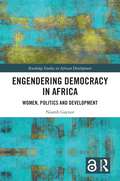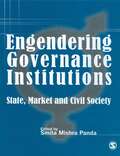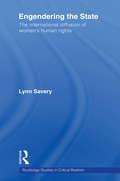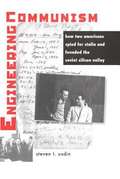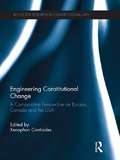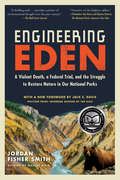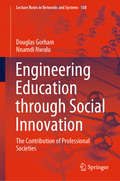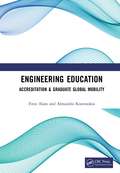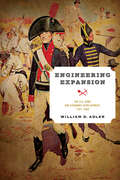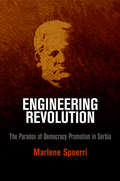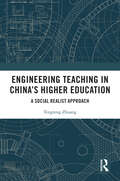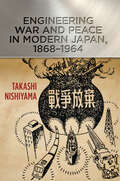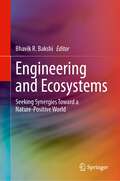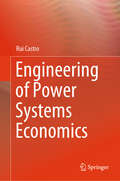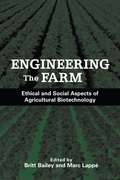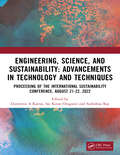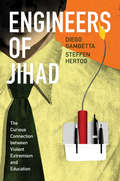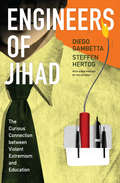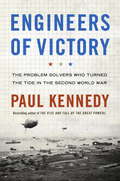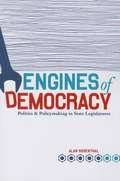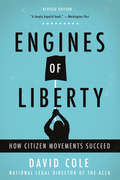- Table View
- List View
Engendering Democracy in Africa: Women, Politics and Development (Routledge Studies in African Development)
by Niamh GaynorThis book investigates women’s political participation in Africa. Going beyond the formal institutions of electoral politics, it explores a range of spaces where everyday politics take place, at national and at local levels. In recent years there have been significant improvements in the number of women elected to parliament in Africa. However, there is little indication that this is translating into better developmental outcomes, and indeed there is mounting evidence that it could in fact help to bolster some authoritarian regimes. Starting from the premise that politics is a far broader project than securing a seat in national or local legislatures alone, this book explores the opportunities for women’s political participation across a number of informal spaces where women and men gather, organise and interact in a more regular and systematic manner. Combining insights from political science, sociology and feminist theory and drawing on detailed cases from the Congo, Kenya, Malawi, Nigeria and Rwanda, it examines how power in its multiple dimensions circulates across a range of everyday political spaces, while drawing attention to the links between domestic gender inequalities and the global political economy. Inviting scholars, practitioners and activists to broaden their focus beyond formal electoral institutions if they want to support women to become more politically active, this book provides fresh insights into major issues at the heart of African studies, development studies, gender and development, democratisation, and international relations.
Engendering Governance Institutions: State, Market and Civil Society
by Smita Mishra PandaThe question of engendering has emerged as a dominant theme in the development theory and practice in the past few years, mainly due to partial achievement of the desired goals of development in terms of attaining gender equality and women`s empowerment. Most studies in this regard focus largely on engendering the state institutions. But the context of development has changed in developing countries with the introduction of recent economic reforms. Taking note of the changed scenario, this book broadens the framework of analysis of engendering governance institutions by incorporating the institutions of market and civil society, besides the state, with a special focus on India. This book will prove valuable for university students, researchers, teachers, administrators and social activists engaged in women`s empowerment and other advocacy issues.
Engendering the State: The International Diffusion of Women's Human Rights (Routledge Studies in Critical Realism)
by Lynn SaveryWhy have states in general been slower to incorporate the international diffusion of women’s human rights norms domestically than other human rights norms and why has the diffusion of these norms varied so greatly between states? Why are some states more responsive and exert more effort than others to comply with these norms? Engendering the State explains these key issues and argues that the gender biased identity of many states represents the most significant barrier to diffusion. It also explores how particular norms have diffused into certain states at specific points in time, as a consequence of international and domestic pressure. The author: addresses the limitations of existing explanations of international norms case studies of Germany, Spain, Japan and India, which provide a new perspective on comparative analysis of Europe and Asia alternative arguments on cross-national variation and the influence of international norms of sexual discrimination the theoretical and practical implications of the argument. This book is essential to those with an interest in the topical subject of women’s human rights, gender studies and international studies.
Engineering Communism: How Two Americans Spied for Stalin and Founded the Soviet Silicon Valley
by Steven T. UsdinEngineering Communism is the fascinating story of Joel Barr and Alfred Sarant, dedicated Communists and members of the Rosenberg spy ring, who stole information from the United States during World War II that proved crucial to building the first advanced weapons systems in the USSR. On the brink of arrest, they escaped with KGB's help and eluded American intelligence for decades. Drawing on extensive interviews with Barr and new archival evidence, Steve Usdin explains why Barr and Sarant became spies, how they obtained military secrets, and how FBI blunders led to their escape. He chronicles their pioneering role in the Soviet computer industry, including their success in convincing Nikita Khrushchev to build a secret Silicon Valley. The book is rich with details of Barr's and Sarant's intriguing and exciting personal lives, their families, as well as their integration into Russian society. Engineering Communism follows the two spies through Sarant's death and Barr's unbelievable return to the United States.
Engineering Constitutional Change: A Comparative Perspective on Europe, Canada and the USA (Routledge Research in Constitutional Law #52)
by Xenophon ContiadesThis volume provides a holistic presentation of the reality of constitutional change in 18 countries (the 15 old EU member states, Canada, Switzerland and the USA). The essays offer analysis on formal and informal constitutional amendment bringing forth the overall picture of the parallel paths constitutional change follows, in correlation to what the constitution means and how constitutional law works. To capture the patterns of constitutional change, multi-faceted parameters are explored such as the interrelations between form of government, party system, and constitutional amendment; the interplay between constitutional change and the system of constitutionality review; the role of the people, civil society, and experts in constitutional change; and the influence of international and European law and jurisprudence on constitutional reform and evolution. In the extensive final, comparative chapter, key features of each country’s amendment procedures are epitomized and the mechanisms of constitutional change are explained on the basis of introducing five distinct models of constitutional change. The concept of constitutional rigidity is re-approached and broken down to a set of factual and institutional rigidities. The classification of countries within models, in accordance with the way in which operative amending mechanisms connect, leads to a succinct portrayal of different modes of constitutional change engineering. This book will prove to be an invaluable tool for approaching constitutional revision either for theoretical or for practical purposes and will be of particular interest to students and scholars of constitutional, comparative and public law.
Engineering Digitised Borders: Designing and Managing the Visa Information System
by Georgios GlouftsiosThis book focuses on the Visa Information System (VIS): a large-scale data infrastructure interconnecting a multiplicity of state authorities that enact border security and migration management in the European Union. The VIS is embedded within a setting of pan-European IT systems that filter international mobility, identify threatening elements, hamper the travels of poor, racialized, and alienated subjects, while at the same time facilitate the circulation of those expected to generate financial and other kinds of capital. The book examines the engineering of the VIS by analyzing how it was designed before its deployment in the field of border security, and how it is maintained to ensure continuous and secure operation. It illustrates how engineering processes that render the VIS functional are not just technoscientific, but inherently political, as they (re)configure and maintain the power to govern international mobility by digital means.
Engineering Eden: A Violent Death, a Federal Trial, and the Struggle to Restore Nature in Our National Parks
by Jordan Fisher Smith“Weaves together a dramatic court case in Los Angeles, a grizzly-bear attack, and a surprisingly fascinating debate . . . a thrilling read.” —The Wall Street JournalWinner of the California Book Award, Silver Medal for NonfictionLonglisted for the PEN/E.O. Wilson Award for Literary Science WritingOne of Outside magazine’s 10 Outdoor Books that Shaped the Last DecadeIn the summer of 1972, twenty-five-year-old Harry Eugene Walker hitchhiked away from his family’s northern Alabama dairy farm to see America. Nineteen days later, he was killed by an endangered grizzly bear in Yellowstone National Park. The ensuing civil trial, brought against the US Department of the Interior for alleged mismanagement of the park’s grizzly population, emerged as a referendum on how America’s most beloved wild places should be conserved. Two of the twentieth century’s greatest wildlife biologists testified—on opposite sides.Moving across decades and among Yellowstone, Yosemite, Glacier, and Sequoia National Parks, former park ranger Jordan Fisher Smith has crafted an epic, emotionally wrenching account of America’s fraught, century-and-a-half-long attempt to remake Eden—in the name of saving it.“This meticulously investigated history of Yellowstone and its wildlife management problems should appeal to fans of Jack Olsen’s classic Night of the Grizzlies.” —Library Journal“A wonderful book . . . Smith uses [Walker’s death] as a narrative focal point to explore science, policy making, bureaucracy, ego, even the law, and when he explores something he goes deep.” —John M. Barry, #1 New York Times–bestselling author of The Great Influenza“First-rate storytelling.” —Seattle Times
Engineering Education through Social Innovation: The Contribution of Professional Societies (Lecture Notes in Networks and Systems #108)
by Douglas Gorham Nnamdi NwuluThis book explores the nexus between professional technical societies and engineering education by examining several societies’ efforts to promote and support engineering and engineering education in the areas of pre-university education, university education and informal education through programs and activities designed to leverage social innovation. Professional societies are in a unique position to support and contribute to engineering education, and have dedicated substantial resources to social responsibility programs and activities that promote engineers and engineering. The book is chiefly intended for engineers, engineering educators, staff members of professional technical societies, and for the broad range of scholars whose work involves technology education and education policy.
Engineering Education: Accreditation & Graduate Global Mobility
by Firoz Alam Alexandra KootsookosThis book details the key concepts, objectives and processes relating to the professional accreditation of engineering bachelor (honours) degrees. The contemporary context of accreditation is examined in terms of the globalised nature of both the engineering profession and higher education. Examples of the processes relating to single and dual accreditation are provided, with examination of the Washington Accord and the requirements of the European Network for Accreditation of Engineering Education. Details are also provided as to how learning outcomes can be structured to demonstrate compliance with accreditation criteria. The final chapters deal briefly with quality assurance processes used in education and the current international quality ranking systems which exist. This book will provide the reader with a detailed examination of outcome based education within the context of Bachelor of Engineering (honours) degrees. A key feature of this book is the side-by-side comparison of different accreditation criteria and a thorough discussion of the relatively new phenomenon of dual accreditation. The book seeks to provide a very clear explanation and exploration of accreditation within the context of engineering education and will benefit those practitioners involved in the accreditation process.
Engineering Expansion: The U.S. Army and Economic Development, 1787-1860 (American Governance: Politics, Policy, and Public Law)
by William D. AdlerEngineering Expansion examines the U.S. Army's role in U.S. economic development from the nation's founding to the eve of the Civil War. William D. Adler starts with a simple question: if the federal government was weak in its early years, how could the economy and the nation have grown so rapidly?Adler answers this question by focusing on the strongest part of the early American state, the U.S. Army. The Army shaped the American economy through its coercive actions in conquering territory, expanding the nation's borders, and maintaining public order and the rule of law. It built roads, bridges, and railroads while Army engineers and ordnance officers developed new technologies, constructed forts that encouraged western settlement and nurtured nascent communities, cleared rivers, and created manufacturing innovations that spread throughout the private sector. Politicians fought for control of the Army, but War Department bureaucracies also contributed to their own development by shaping the preferences of elected officials.Engineering Expansion synthesizes a wide range of historical material and will be of interest to those interested in early America, military history, and politics in the early United States.
Engineering Reality: The Politics of Environmental Impact Assessments and the Just Energy Transition in Colombia
by Cornelia HelmckeEngineering Reality offers unprecedented insights into the power of environmental impact assessments in engineering a reality favourable to any investment, focusing on the highly contested environmental study of a large hydroelectric dam project in southern Colombia, El Quimbo. The inclusion of environmental impact assessments to project proposals of environmental influence has been an undeniably important step to environmental governance in many countries around the world. Regarding the science behind these studies as objective and their results as the closest in representing reality, however, is misleading. Many activists and scholars made it their mission to uncover the limitations and work towards filling the gaps. Participation processes are considered key to any successful evaluation, but local knowledges and alternative perspectives are still often disqualified through more widely accepted scientific methods. Engineering Reality systematically walks through and accounts for the shortcomings and injustices associated with environmental monitoring. It compares the reality as presented in the dam’s environmental impact study with first-hand accounts from the local and affected populations and observations gathered through two periods of fieldwork in 2012 (before) and 2016-17 (after the dam started operating). It explores how the knowledge of the study was used politically and to what end. Bringing the findings in conversation with the wider environmental impact assessment literature, the book proposes a new framework to assess energy projects -Energy Data Justice- that regards the environmental impact assessment a strictly political tool aimed at reaching the just energy transition in Colombia and worldwide.
Engineering Revolution: The Paradox of Democracy Promotion in Serbia
by Marlene SpoerriThe nonviolent overthrow of Balkan dictator Slobodan Milošević in October 2000 is celebrated as democracy promotion at its best. This perceived political success has been used to justify an industry tasked with "exporting" democracy to countries like Belarus, Ukraine, Tunisia, and Egypt. Yet the true extent of the West's involvement in Milošević's overthrow remained unclear until now. Engineering Revolution uses declassified CIA documents and personal interviews with diplomats, aid providers, and policymakers, as well as thousands of pages of internal NGO documents, to explore what proponents consider one of the greatest successes of the democracy promotion enterprise.Through its in-depth examination of the two decades that preceded and followed Milošević's unseating, as well as its critical look at foreign assistance targeting Serbia's troubled political party landscape, Engineering Revolution upends the conventional wisdom on the effectiveness of democracy promotion in Serbia. Marlene Spoerri demonstrates that democracy took root in Serbia in spite of, not because of, Western intervention—in fact, foreign intervention often hurt rather than helped Serbia's tenuous transition to democracy. As Western governments recalibrate their agendas in the wake of the Arab Spring, this timely book offers important lessons for the democracy promotion community as it sets its sights on the Middle East, former Soviet Union, and beyond.
Engineering Teaching in China’s Higher Education: A Social Realist Approach
by Tengteng ZhuangBased on a case study of engineering teaching in China’s higher education sector, this book unravels the interlocking influencing factors that condition the experience of engineering faculty members along with multiple stakeholders’ expectations of engineering teaching.What motivates and demotivates a university instructor to provide excellent teaching, especially in the disciplines where effective instructor guidance is crucial for student learning? This book gives evidence-based answers to this research question, drawing upon a social realist framework in relation to the disciplinary features of engineering and based on both qualitative and quantitative methods. It expatiates upon structural, cultural, and reflexive factors concerning both the academic profession and industry and how teaching behaviors are shaped. In doing so, the author advances pragmatic suggestions for higher education reform under the prevalent performance management systems, posing implications for global higher education in regard to what structural arrangements and cultural milieu should be in place to unleash the potential of engineering teaching.The book will appeal to scholars of higher education, Chinese and comparative education, and education sociology, and academics and policy-makers interested in engineering education and teacher education.
Engineering War and Peace in Modern Japan, 1868–1964 (Johns Hopkins Studies in the History of Technology)
by Takashi NishiyamaThe role of engineering communities in taking Japan from a defeated war machine into a peacetime technology leader.Naval, aeronautic, and mechanical engineers played a powerful part in the military buildup of Japan in the early and mid-twentieth century. They belonged to a militaristic regime and embraced the importance of their role in it. Takashi Nishiyama examines the impact of war and peace on technological transformation during the twentieth century. He is the first to study the paradoxical and transformative power of Japan’s defeat in World War II through the lens of engineering.Nishiyama asks: How did authorities select and prepare young men to be engineers? How did Japan develop curricula adequate to the task (and from whom did the country borrow)? Under what conditions? What did the engineers think of the planes they built to support Kamikaze suicide missions? But his study ultimately concerns the remarkable transition these trained engineers made after total defeat in 1945. How could the engineers of war machines so quickly turn to peaceful construction projects such as designing the equipment necessary to manufacture consumer products? Most important, they developed new high-speed rail services, including the Shinkansen Bullet Train. What does this change tell us not only about Japan at war and then in peacetime but also about the malleability of engineering cultures?Nishiyama aims to counterbalance prevalent Eurocentric/Americentric views in the history of technology. Engineering War and Peace in Modern Japan, 1868–1964 sets the historical experience of one country’s technological transformation in a larger international framework by studying sources in six different languages: Chinese, English, French, German, Japanese, and Spanish. The result is a fascinating read for those interested in technology, East Asia, and international studies. Nishiyama's work offers lessons to policymakers interested in how a country can recover successfully after defeat.
Engineering and Ecosystems: Seeking Synergies Toward a Nature-Positive World
by Bhavik R. BakshiThis book demonstrates how the inclusion of nature in engineering decisions results in innovative solutions that are economically feasible, ecologically viable, and socially desirable. It advances progress toward nature-positive decisions by protection and restoration of ecosystems and respect for ecological boundaries. The topic of this book is an active area of academic research, and leading companies are including goals associated with ecosystem services in their sustainability plans. This book is the first collection of methods and applications that explicitly include the role of nature in supporting engineering activities and describes the role that ecosystems play in supporting technology and industry. It describes approaches, models, applications, and challenges for innovation and sustainability that will be useful to students and practitioners.
Engineering of Power Systems Economics
by Rui CastroThis textbook is a comprehensive resource designed for university master's students on power systems, with a focus on engineering-related aspects. It covers all the fundamental principles of power systems economics.PhD students seeking to enhance their understanding of power systems economics from an engineering standpoint will also benefit from this book. It offers in-depth analysis and detailed insights into economic engineering aspects, presenting various models that are meticulously explained.Furthermore, practising engineers from all disciplines will find this book useful as it provides practical solutions to real-world engineering issues. Through worked examples and solved problems derived from existing installations, professionals can apply the knowledge gained in their everyday work. From a broader perspective, the book caters to the growing number of individuals interested in the economics of power systems, whether driven by professional obligations or self-education.What sets this book apart from existing literature is its unique approach, establishing a strong connection between economics and engineering. Unlike traditional texts that predominantly focus on economic theory, this book bridges the gap by offering practical applications within the power system context. The first part looks into classic economic theory, exploring subjects such as producers and consumers, market behavior, and general market structures, always with a clear connection to power systems. Numerous examples from the power system industry enrich the learning experience. In the second part, the theory presented in the first section is applied to power system-specific problems. These include an in-depth examination of different costs in power systems, regulation strategies, and the intricacies of electricity markets.Overall, this book provides a valuable resource for universitystudents, PhD candidates, and engineers alike, offering a unique blend of economic theory and engineering applications.
Engineering the Farm: The Social and Ethical Aspects of Agricultural Biotechnology
by Britt Bailey Marc LappeEngineering the Farm offers a wide-ranging examination of the social and ethical issues surrounding the production and consumption of genetically modified organisms (GMOs), with leading thinkers and activists taking a broad theoretical approach to the subject. Topics covered include: the historical roots of the anti-biotechnology movement ethical issues involved in introducing genetically altered crops questions of patenting and labeling the "precautionary principle" and its role in the regulation of GMOs effects of genetic modification on the world's food supply ecological concerns and impacts on traditional varieties of domesticated crops potential health effects of GMOsContributors argue that the scope, scale, and size of the present venture in crop modification is so vast and intensive that a thoroughgoing review of agricultural biotechnology must consider its global, moral, cultural, and ecological impacts as well as its effects on individual consumers. Throughout, they argue that more research is needed on genetically modified food and that consumers are entitled to specific information about how food products have been developed.Despite its increasing role in worldwide food production, little has been written about the broader social and ethical implications of GMOs. Engineering the Farm offers a unique approach to the subject for academics, activists, and policymakers involved with questions of environmental policy, ethics, agriculture, environmental health, and related fields.
Engineering the Financial Crisis
by Jeffrey Friedman Wladimir KrausThe financial crisis has been blamed on reckless bankers, irrational exuberance, government support of mortgages for the poor, financial deregulation, and expansionary monetary policy. Specialists in banking, however, tell a story with less emotional resonance but a better correspondence to the evidence: the crisis was sparked by the international regulatory accords on bank capital levels, the Basel Accords.In one of the first studies critically to examine the Basel Accords, Engineering the Financial Crisis reveals the crucial role that bank capital requirements and other government regulations played in the recent financial crisis. Jeffrey Friedman and Wladimir Kraus argue that by encouraging banks to invest in highly rated mortgage-backed bonds, the Basel Accords created an overconcentration of risk in the banking industry. In addition, accounting regulations required banks to reduce lending if the temporary market value of these bonds declined, as they did in 2007 and 2008 during the panic over subprime mortgage defaults.The book begins by assessing leading theories about the crisis--deregulation, bank compensation practices, excessive leverage, "too big to fail," and Fannie Mae and Freddie Mac--and, through careful evidentiary scrutiny, debunks much of the conventional wisdom about what went wrong. It then discusses the Basel Accords and how they contributed to systemic risk. Finally, it presents an analysis of social-science expertise and the fallibility of economists and regulators. Engagingly written, theoretically inventive, yet empirically grounded, Engineering the Financial Crisis is a timely examination of the unintended--and sometimes disastrous--effects of regulation on complex economies.
Engineering, Science, and Sustainability: Advancements in Technology and Techniques
by Dimitrios A Karras Sai Kiran Oruganti Sudeshna RayISC 2022 is dedicated to the Niti Aayog policies to promote sustainability through exchange of ideas emerging out of the academia. The ISC is an annual conference that is held in virtual mode until COVID restrictions on travel exist. The vision of the conference is to capacitate Academia with the necessary ideas that provide insights of the grassroot level development to various stakeholders of the Niti-Aayog policies. Towards this goal, the conference creates a conjunction of various stakeholders of Niti-Aayog policies that include- academic institutions, government bodies, policy makers and industry. The ISC organizers make concerted efforts to promote academic research that would technological, scientific, management & business practices, and insights into policy merits & disruptions. The framework of exchange of ideas is geared towards adoption of deep technologies, fundamental sciences & engineering, energy research, energy policies, advances in medicine & related case studies. This framework enables the round table discussions between the academia, industry and policy makers through its range of plenary and keynote speakers.
Engineers of Jihad
by Diego Gambetta Steffen HertogThe violent actions of a few extremists can alter the course of history, yet there persists a yawning gap between the potential impact of these individuals and what we understand about them. In Engineers of Jihad, Diego Gambetta and Steffen Hertog uncover two unexpected facts, which they imaginatively leverage to narrow that gap: they find that a disproportionate share of Islamist radicals come from an engineering background, and that Islamist and right-wing extremism have more in common than either does with left-wing extremism, in which engineers are absent while social scientists and humanities students are prominent. Searching for an explanation, they tackle four general questions about extremism: Under which socioeconomic conditions do people join extremist groups? Does the profile of extremists reflect how they self-select into extremism or how groups recruit them? Does ideology matter in sorting who joins which group? Lastly, is there a mindset susceptible to certain types of extremism? Using rigorous methods and several new datasets, they explain the link between educational discipline and type of radicalism by looking at two key factors: the social mobility (or lack thereof) for engineers in the Muslim world, and a particular mindset seeking order and hierarchy that is found more frequently among engineers. Engineers' presence in some extremist groups and not others, the authors argue, is a proxy for individual traits that may account for the much larger question of selective recruitment to radical activism. Opening up markedly new perspectives on the motivations of political violence, Engineers of Jihad yields unexpected answers about the nature and emergence of extremism.
Engineers of Jihad: The Curious Connection between Violent Extremism and Education
by Diego Gambetta Steffen HertogThe violent actions of a few extremists can alter the course of history, yet there persists a yawning gap between the potential impact of these individuals and what we understand about them. In Engineers of Jihad, Diego Gambetta and Steffen Hertog uncover two unexpected facts, which they imaginatively leverage to narrow that gap: they find that a disproportionate share of Islamist radicals come from an engineering background, and that Islamist and right-wing extremism have more in common than either does with left-wing extremism, in which engineers are absent while social scientists and humanities students are prominent.Searching for an explanation, they tackle four general questions about extremism: Under which socioeconomic conditions do people join extremist groups? Does the profile of extremists reflect how they self-select into extremism or how groups recruit them? Does ideology matter in sorting who joins which group? Lastly, is there a mindset susceptible to certain types of extremism?Using rigorous methods and several new datasets, they explain the link between educational discipline and type of radicalism by looking at two key factors: the social mobility (or lack thereof) for engineers in the Muslim world, and a particular mindset seeking order and hierarchy that is found more frequently among engineers. Engineers' presence in some extremist groups and not others, the authors argue, is a proxy for individual traits that may account for the much larger question of selective recruitment to radical activism.Opening up markedly new perspectives on the motivations of political violence, Engineers of Jihad yields unexpected answers about the nature and emergence of extremism.
Engineers of Victory
by Paul KennedyPaul Kennedy, award-winning author of The Rise and Fall of the Great Powers and one of today's most renowned historians, now provides a new and unique look at how World War II was won. Engineers of Victory is a fascinating nuts-and-bolts account of the strategic factors that led to Allied victory. Kennedy reveals how the leaders' grand strategy was carried out by the ordinary soldiers, scientists, engineers, and businessmen responsible for realizing their commanders' visions of success.In January 1943, FDR and Churchill convened in Casablanca and established the Allied objectives for the war: to defeat the Nazi blitzkrieg; to control the Atlantic sea lanes and the air over western and central Europe; to take the fight to the European mainland; and to end Japan's imperialism. Astonishingly, a little over a year later, these ambitious goals had nearly all been accomplished. With riveting, tactical detail, Engineers of Victory reveals how.Kennedy recounts the inside stories of the invention of the cavity magnetron, a miniature radar "as small as a soup plate," and the Hedgehog, a multi-headed grenade launcher that allowed the Allies to overcome the threat to their convoys crossing the Atlantic; the critical decision by engineers to install a super-charged Rolls-Royce engine in the P-51 Mustang, creating a fighter plane more powerful than the Luftwaffe's; and the innovative use of pontoon bridges (made from rafts strung together) to help Russian troops cross rivers and elude the Nazi blitzkrieg. He takes readers behind the scenes, unveiling exactly how thousands of individual Allied planes and fighting ships were choreographed to collectively pull off the invasion of Normandy, and illuminating how crew chiefs perfected the high-flying and inaccessible B-29 Superfortress that would drop the atomic bombs on Japan.The story of World War II is often told as a grand narrative, as if it were fought by supermen or decided by fate. Here Kennedy uncovers the real heroes of the war, highlighting for the first time the creative strategies, tactics, and organizational decisions that made the lofty Allied objectives into a successful reality. In an even more significant way, Engineers of Victory has another claim to our attention, for it restores "the middle level of war" to its rightful place in history.Advance praise for Engineers of Victory "Paul Kennedy's history of World War II is a demonstration not only of incisive analysis and mastery of subject, but of profound integrity, and a historian's desire to celebrate not great leaders but the forgotten scientists, technicians, and logisticians who gave us the tactical edge, without which the strategic designs could never have been achieved."--Robert D. Kaplan, author of The Revenge of Geography "Kennedy's fine-grained analysis and suspicion of any one single cause--like cipher cracking, intelligence and deception operations, or specific weapons systems, like the Soviet T-34 tank--permit him to persuasively array his supporting facts. . . . An absorbing new approach to a well-worked field."--Kirkus Reviews (starred review) "A fresh and stimulating approach."--Publishers WeeklyFrom the Hardcover edition.
Engines Of Democracy: Politics And Policymaking In State Legislatures
by Alan RosenthalState legislators have often been in the shadow of their national counterparts, but they drive the processes of democracy. Rosenthal brings together a lifetime of research and experience on state legislative politics into one eminently readable volume, Building on earlier work with new data and recent interviews and observations, Both a complement and contrast to the policymaking process on Capitol Hill, Engines of Democracy proves that no one gives insight into state legislators and their work the way Alan Rosenthal can.
Engines of Democracy: Politics and Policymaking in State Legislatures
by Alan RosenthalState legislators have often been in the shadow of their national counterparts, but they drive the processes of democracy. Rosenthal brings together a lifetime of research and experience on state legislative politics into one eminently readable volume—a dynamic, inside view of the people involved, the politics that prevail, and the interest groups and lobbyists who advocate their causes. Building on earlier work with new data and recent interviews and observations, Rosenthal looks at the way representation works, Americans’ critical view of their legislatures, the role of legislative leaders, the dynamics of executive-legislative relationships, as well as norms and ethics. Both a complement and contrast to the policymaking process on Capitol Hill, Engines of Democracy proves that no one gives insight into state legislators and their work the way Alan Rosenthal can.
Engines of Liberty: The Power of Citizen Activists to Make Constitutional Law
by David ColeHow did gay and lesbian couples' right to marry go from unthinkable to inevitable? How did the individual right to bear arms, dismissed as fraudulent by Chief Justice Warren Burger in 1990, become a constitutional right in 2008? And what compelled President George W. Bush to rein in many of his initiatives in the war on terror before leaving office, even though past presidents have had a free hand in wartime? We are likely to answer that, in each case, the Supreme Court remade our nation's most fundamental law.Yet as the award-winning legal scholar David Cole argues in Engines of Liberty, citizen activists are the true drivers of constitutional change. Drawing on interviews with participants in the most successful rights movements of the last 30 years, he shows that time and again, associations of ordinary Americans confronting long odds have managed to transform the nation's highest law. And they have done so largely through advocacy outside the federal courts altogether.We witness marriage equality advocates in the 1980s and 1990s uniting behind a strategy of state-based incrementalism that paved the way for their historic Supreme Court victory. We see the NRA building a loyal and active membership base that can swing elections and influence state and federal law, thereby shaping the debate about guns at the Supreme Court. And we watch as civil liberties and human rights groups encourage foreign populations and governments to challenge the president when few domestic institutions would.Offering a new vision of the role we all play in shaping our Constitution and illuminating the tactics successful reform campaigns have employed, Engines of Liberty restores faith in the power of citizen activists to help shape our nation's future.
